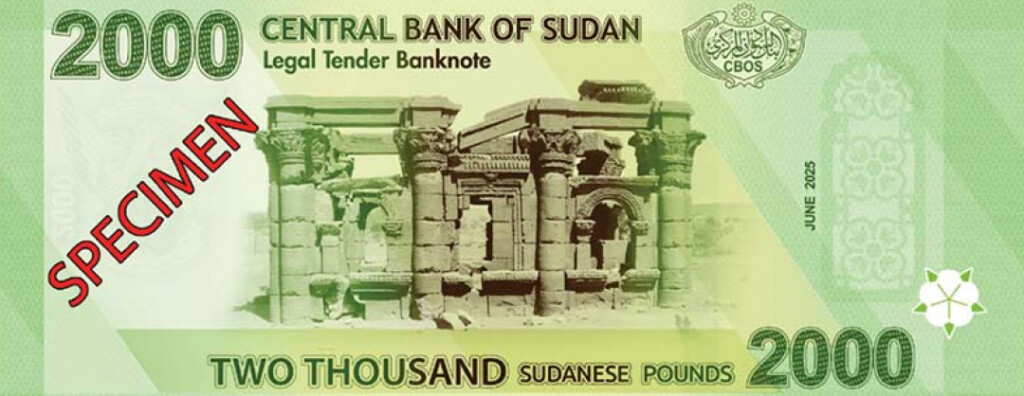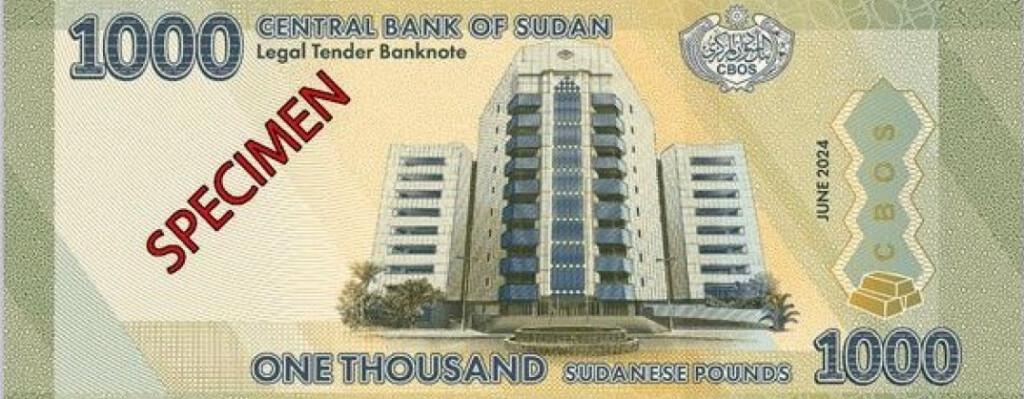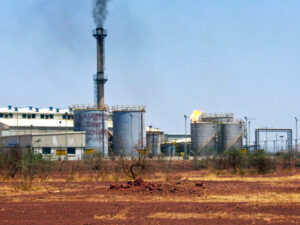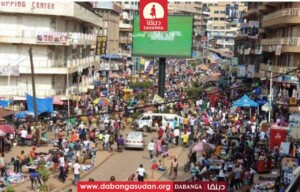New SDG 2,000 banknote ‘reflects contradictory policy by Central Bank of Sudan’

The new SDG 2,000 note dated June 2025 (Source: CBoS)
The announcement by the Central Bank of Sudan (CBoS) that it is issuing a new SDG 2,000 banknote – and entirely new denomination – , as well as the issuance of a new SDG 500 banknote, reflects “a dual and contradictory monetary policy”, says financial analyst Ahmed Ben Omar in an interview with Radio Dabanga.
In its statement, the CBoS said that the decision to issue the new comes under the provisions of the Central Bank of Sudan Law of 2002 and its subsequent amendments, explaining that the step comes within the framework of protecting the national currency, stabilizing its exchange rate and helping to achieve economic stability.
Speaking to Radio Dabanga today, financial analyst Ahmed Ben Omar asserts that that the incentives for the issuance of a 2,000-pound currency began early and came to light last October following the appointment of the new governor of the Central Bank, Amna Mirghani.

Contradiction in monetary policy
Ben Omar explains that “the decision reflects a dual and contradictory monetary policy, pointing to the existence of monetary expansion represented in the increase in currency printing to cover the government’s obligations and finance the current deficit, which is offset by administrative tightening through the bank’s attempts to control the parallel market and besiege cash circulation outside the banking system.”
He stresses that this approach represents a contradiction between the objective of liquidity pressure and the objective of controlling the exchange rate, especially in light of the absence of real money market tools such as open market operations.

Rising prices and rising inflation
Ben Omar predicts that the introduction of the new denomination will lead to a significant increase in the speed of cash circulation due to the ease of dealing with the large denomination, which will lead to higher prices in the short term. It will also contribute to a decrease in the relative demand for small denominations, which will ease the operational pressure on the monetary system, he told Radio Dabanga.
‘Any new monetary issuance that is not linked to real production or foreign reserves means an increase in the monetary mass, which in turn leads to negative pressure on the value of the Sudanese pound…’
“The most dangerous factor is that the decision raises the public’s inflation expectations, and these expectations in themselves feed inflation later, making the move more of an expansionary signal than a real monetary reform.”
As for the impact of the decision on the exchange rate, Ben Omar says that any new monetary issuance that is not linked to real production or foreign reserves means an increase in the monetary mass, which in turn leads to negative pressure on the value of the Sudanese pound.
“With the central bank abandoning its policy of buying gold as a means of curbing excess liquidity, this monetary expansion becomes sterile, further exacerbating its negative impact on the exchange rate,” he added.

Potential positive effects
Ben Omar predicts that there will be positive effects if the Central Bank succeeds in effectively controlling the proceeds of exports of commodities such as gold, sesame and livestock, and supplying them through official channels.
He notes that the decision could also boost reserves and support the stability of the pound by providing foreign currency within banks.
Ben Omar asserts that contingent to the success of this scenario is strict discipline in implementation, stressing that any leakage of proceeds issued outside the banking system will make monetary policy lose its effectiveness, and keep the pound under constant pressure in the parallel market.
Devastating losses
In an earlier interview with Radio Dabanga in October, economist and former Minister of Finance of Sudan, Dr Ibrahim El Badawi: $200 billion in devastating losses of war for Sudan’s infrastructure; 40 per cent of GDP, destroyed in the first year of the war; $6 billion in losses in the capital Khartoum and its environs.
“The incompatibility of the city forces will push the quartet for easy solutions, by reformulating the duality of El Burhan and Hemedti. The only way out of Sudan’s existential crisis is the agreement of civil forces on a comprehensive national charter Four possible scenarios for Sudan’s future, the worst of which is the continuation of the war, fragmentation, and the carving out of its territories from neighbouring countries.”
Economic and financial analyst Ahmed Ben Omar told Radio Dabanga that the exchange rate increase during May amounted to EGP 61, equivalent to 32% of the total increase since the beginning of the year, reaching EGP 193.
He explained that the US Dollar exchange rate rose in the parallel market from 2,550 EGP to 2,743 EGP, an increase of 193 EGP, by (+7.57%). In the official market (according to the Bank of Khartoum), the dollar rose from EGP 2,001.91 to EGP 2,156.05, an increase of 154.14 EGP (+7.7% approx.)
He pointed to the convergence of the rate of increase between the official and parallel market, with the gap between the two prices continuing. He described the exchange rate rates in the first half of this year as stable compared to last year and the previous year. One dollar was worth about 580 Sudanese Pounds in mid-April of 2023, just before the outbreak of the war, rising in more than two years by 472%.
Fragility
Economic analyst Ahmed Ben Omar said that the Bank of Sudan’s policy of limiting liquidity and reducing cash circulation helped to some extent in absorbing (internal) speculation, but at the same time stressed that this did not prevent the rapid impact in the parallel market in the event of abnormal shocks directly related to military operations.
He explained that indicators show that the market remains fragile, reacting more strongly to military events than economic data, but at a less volatile pace.
Broad economic downturn
Sudan’s economy contracted by an additional 13.5 % in 2024, after shrinking by about a third the previous year, while extreme poverty is expected to cover 71 % of the population as the conflict continues, the World Bank said.
The bank said in a report on Tuesday that even if a solution to the conflict is reached in the coming months and important structural reforms are implemented, Sudan’s economy is unlikely to return to its pre-conflict GDP level before 2031.
The bank attributed the significant deterioration of the Sudanese economy to the noticeable collapse in the indicators of the main productive sectors, especially the agricultural sector, which witnessed a sharp decline in productivity due to the interruption of trade routes, the displacement of farmers, the destruction of agricultural infrastructure, and the lack of access to finance.
Poverty rates jumped to 71% from 33% in 2022, due to households losing their sources of income, and unemployment rates rising from 32% in 2022 to 47% in 2024, due to widespread business closures, economic uncertainty, and a sharp decline in stable job opportunities due to the severe impact of the conflict on the labour market.











 and then
and then